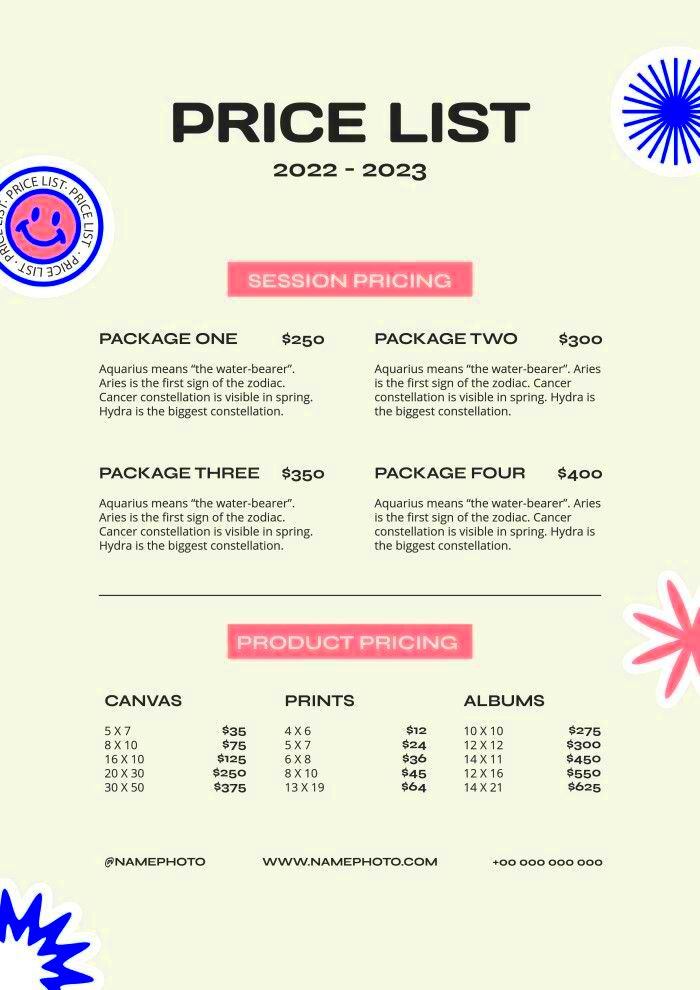Freelance photography has become a popular and lucrative career choice for many creative individuals. It offers flexibility, the chance to work with a variety of clients, and the ability to showcase unique artistic skills. As a freelance photographer, you are in control of your work, your schedule, and your pricing. However, understanding how to price your photography services effectively is crucial to attracting clients and building a sustainable business. In this post, we will explore the factors that influence photography service pricing, different types of photography services, and how to set your rates based on your expertise and market demand.
Factors That Affect the Pricing of Photography Services

Several factors play a role in determining the price of photography services. These factors depend on your experience, the type of photography, and the specific requirements of your clients. Here are some key aspects that affect pricing:
- Experience and Skill Level: More experienced photographers with a strong portfolio can charge higher rates. Clients are willing to pay more for professionals with proven skills and a good reputation.
- Location: The cost of living in your area can affect your pricing. For instance, photographers in cities with a higher cost of living might charge more than those in rural areas.
- Equipment and Editing: The quality of your gear and the time spent on post-production can impact your pricing. High-end equipment and detailed editing require more time and investment.
- Market Demand: Popular photography niches or peak seasons (like weddings or holidays) might allow you to charge higher rates.
- Type of Photography: Some photography types, like commercial or event photography, may demand a premium price compared to simpler portrait shoots.
Also Read This: What is Better Than Fiverr: Exploring Alternative Platforms for Freelancers
Different Types of Photography Services and Their Pricing
As a freelance photographer, you can specialize in a variety of photography services. Each type of photography has its own pricing structure based on the complexity, location, and duration of the work involved. Here are some common photography services and their average pricing:
| Photography Type | Price Range |
|---|---|
| Portrait Photography | $150 - $500 per session |
| Event Photography | $500 - $2,500+ depending on event size |
| Wedding Photography | $1,500 - $5,000+ depending on package and experience |
| Product Photography | $200 - $1,500+ depending on complexity |
| Real Estate Photography | $200 - $1,000+ depending on property size |
| Commercial Photography | $500 - $5,000+ depending on project scale |
Each type of photography comes with different expectations and requirements, so the prices can vary significantly. Keep in mind that these prices are just averages; your rates should reflect your experience, the quality of your work, and the market demand in your area.
Also Read This: How to Open a Gig on Fiverr
How to Set Your Photography Service Prices
Setting the right price for your photography services is crucial to attract clients while ensuring you’re earning what you deserve. To determine your rates, you need to consider your costs, market conditions, and the value you bring to your clients. Here are some steps to help you set fair and competitive prices:
- Know Your Costs: Before setting your prices, calculate all your expenses, such as equipment, software, marketing, and travel costs. Make sure your prices cover these expenses while still allowing you to make a profit.
- Research the Market: Research what other photographers in your area and niche charge. Look at competitors’ portfolios, experience levels, and service offerings to understand where you stand.
- Consider Your Experience and Skills: If you’re just starting out, you may need to set lower prices to build a portfolio. As you gain more experience, you can gradually increase your rates to reflect your expertise.
- Package Your Services: Offering packages can make pricing easier for clients and give you a chance to upsell. For example, you can offer a basic photo shoot package, a premium package with more hours or edited photos, and a deluxe package with extras like albums or prints.
- Value Your Time: Consider how much time each session and post-production work takes. Charging per hour or offering fixed session prices can help you keep track of your time and income.
Remember, setting your prices should be an ongoing process that you adjust based on demand, client feedback, and your own growth as a photographer.
Also Read This: How to Contact Fiverr by Email
How Freelance Photographers Can Stand Out in a Competitive Market
The photography industry is competitive, but there are several ways to make your freelance photography services stand out from the crowd. Whether you're just starting out or looking to grow your business, these tips can help you carve a niche for yourself:
- Build a Strong Portfolio: A well-organized, high-quality portfolio is key to attracting clients. Focus on showcasing your best work and tailor your portfolio to your target audience, whether it’s weddings, portraits, or commercial photography.
- Develop Your Personal Brand: Your brand is more than just your logo. It includes your photography style, how you communicate with clients, and your overall reputation. Consistently deliver great work and provide excellent customer service to build trust.
- Offer Exceptional Customer Service: In a competitive market, excellent service can set you apart. Respond to inquiries promptly, be clear about your pricing and policies, and ensure that the client experience is smooth and professional from start to finish.
- Specialize in a Niche: Focusing on a specific type of photography, such as pet photography, corporate headshots, or maternity shoots, can help you stand out as an expert in that field. Specialization often allows you to charge higher rates due to your expertise.
- Leverage Social Media: Use platforms like Instagram, Pinterest, and Facebook to showcase your work. Engaging with your audience through regular posts, behind-the-scenes content, and client testimonials can boost your visibility and credibility.
- Network with Other Professionals: Building relationships with other photographers, vendors, and businesses can lead to referrals and collaborative opportunities. Attend industry events, workshops, and online forums to expand your network.
Standing out requires consistency and dedication, but with the right strategies, you can create a distinctive presence in the photography market.
Also Read This: Why Does Fiverr Withhold Earnings?
Common Pricing Mistakes to Avoid as a Freelance Photographer
Pricing your photography services can be tricky, and making the wrong decisions can hurt your business. Here are some common pricing mistakes that many freelance photographers make and how to avoid them:
- Undervaluing Your Work: One of the biggest mistakes is setting prices too low in an attempt to get clients. While it might attract business at first, it often leads to burnout, and clients may perceive your services as less valuable. Don’t be afraid to charge what your skills are worth.
- Not Factoring in All Costs: If you forget to account for expenses like equipment, software, or travel, you might end up working for less than minimum wage. Always include your costs in your pricing and ensure you are making a profit.
- Ignoring Market Trends: Pricing too high or too low compared to industry standards can limit your ability to attract clients. Research your market regularly and adjust your prices based on demand and competition.
- Overcomplicating Pricing: While it’s great to offer packages, overcomplicating your pricing with too many options can confuse potential clients. Keep your pricing simple and transparent to make it easy for clients to understand.
- Not Offering Flexible Payment Terms: Offering flexible payment options can make it easier for clients to commit. Consider providing installment plans or offering discounts for upfront payments.
- Neglecting Post-Production Time: Sometimes photographers don’t account for the time spent on editing, which can lead to undercharging for the final product. Always include your post-production time in your pricing to avoid losing money.
By avoiding these mistakes, you can ensure your pricing strategy is fair, sustainable, and attractive to potential clients.
Also Read This: How Much Freelance Proofreaders Make
Frequently Asked Questions
As a freelance photographer, you may have some questions about setting prices and managing your business. Here are some frequently asked questions that can help clarify the process:
- How do I know if my prices are too high or too low?
It's essential to research your local market and compare your prices to other photographers with similar experience. If you're getting too few inquiries, your prices might be too high. On the other hand, if you're constantly booked up, it might be time to consider raising your rates. - Should I offer discounts to attract clients?
Discounts can be useful, but avoid offering them too often as it may devalue your services. Instead, consider offering discounts for repeat clients or for specific services like booking multiple sessions in advance. - How can I increase my rates over time?
As your experience and portfolio grow, you can gradually increase your rates. A good approach is to raise your prices once you’ve established a loyal client base and your demand increases. Always notify your clients in advance of any price changes. - What if a client asks for additional services outside the scope of the agreement?
It’s important to clearly outline the scope of your services in a contract before starting the project. If a client requests additional work, be upfront about extra charges for these additional services. - Is it necessary to have a contract with clients?
Yes, having a contract is highly recommended. It protects both you and the client, ensuring that expectations are clear regarding pricing, timelines, and deliverables.
Conclusion
Setting the right price for your freelance photography services is crucial for attracting clients while maintaining profitability. By considering factors like experience, market demand, and the type of photography, you can establish fair pricing that reflects the value of your work. As your business grows, don’t forget to update your rates accordingly and avoid common pricing mistakes. With consistent effort and the right strategies, you’ll be able to stand out in the competitive photography market.




